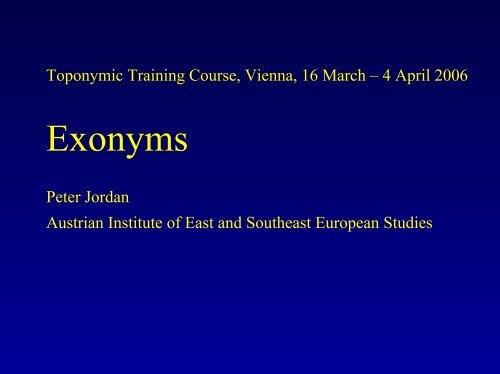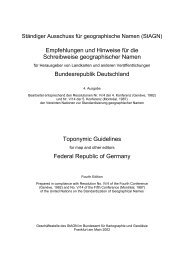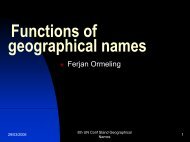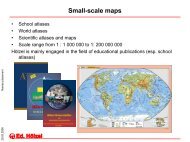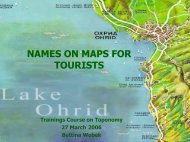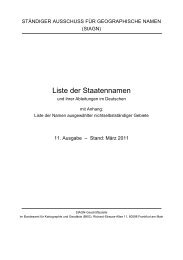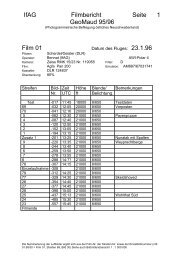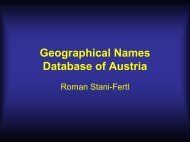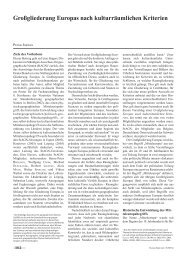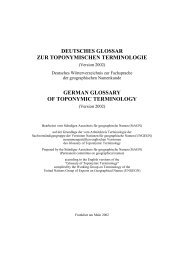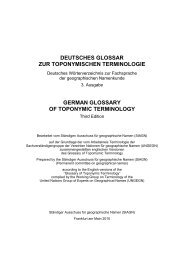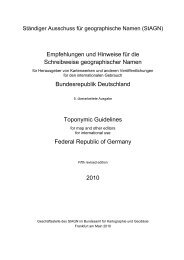Exonyms
Exonyms
Exonyms
You also want an ePaper? Increase the reach of your titles
YUMPU automatically turns print PDFs into web optimized ePapers that Google loves.
Toponymic Training Course, Vienna, 16 March – 4 April 2006<br />
<strong>Exonyms</strong><br />
Peter Jordan<br />
Austrian Institute of East and Southeast European Studies
DEFINITIONS<br />
Exonym = conventional name = traditional name<br />
Endonym = internal denomination of a geographical feature<br />
Exonym = external denomination of a geographical feature<br />
Endonym = name in the language of the local population<br />
Exonym = name in another language
UNGEGN Glossary<br />
Endonym = Name of a geographical feature in one of the<br />
languages occurring in the area where the feature is situated<br />
Exonym = Name used in a specific language for a geographical<br />
feature situated outside the area where that language has official<br />
status, and differing in its form from the name used in the<br />
official language or languages of the area where the<br />
geographical feature is situated
Proposal UNGEGN WG on <strong>Exonyms</strong><br />
Endonym = Name of a geographical feature in an official or<br />
well-established language occurring in that area where the<br />
feature is located.<br />
Exonym = Name used in a specific language for a geographical<br />
feature situated outside the area where that language is spoken,<br />
and differing in its form from the name used in an official or<br />
well-established language of that area where the geographical<br />
feature is located..
EXAMPLES FROM PRACTICE.
S 1a: Geografski atlas Slovenije [Geographical Atlas of<br />
Slovenia], Ljubljana 1998<br />
S 1b: National Atlas of Slovenia, Ljubljana 2001<br />
C 1: A Concise Atlas of the Republic of Croatia & of the<br />
Republic of Bosnia and Hercegovina, Zagreb 1993<br />
C 2: Veliki atlas Hrvatske [Large Atlas of Croatia], Zagreb<br />
2002<br />
PL: Atlas Śląska dolnego i opolskiego [Atlas of Lower and<br />
Opole Silesia], Wrocław 1997<br />
RO: România. Atlas istorico-geografic [Romania. Historicalgeographical<br />
Atlas]. Bucureşti 1996
S 1a<br />
Geographical Atlas of Slovenia<br />
Ljubljana 1998<br />
monolingual Slovene
S 1a<br />
S. 14 Ausschnitt La Coruna mit rt Finisterre
S 1a<br />
S. 14 Ausschnitt Champagne
S 1a<br />
S. 14 Ausschnitt Tauern
S 1a<br />
S. 14 Ausschnitt Lissabon
S 1a<br />
S. 16 Ausschnitt Norditalien
S 1b<br />
National Atlas of Slovenia<br />
Ljubljana 2001<br />
monolingual English
S 1b<br />
S. 21 Ausschnitt Südkärnten (AUSTRIA noch<br />
drauf)
S 1b<br />
S. 185 Ausschnitt Glossary (rechts oben)
C 1<br />
A Concise Atlas of the Republic of Croatia<br />
&<br />
of the Republic of Bosnia and Hercegovina<br />
Zagreb 1993<br />
monolingual English
C 1<br />
S. 10 Ausschnitt Iberische Halbinsel
C 1<br />
S. 12 Ausschnitt Triest
C 2<br />
Large Atlas of Croatia<br />
Zagreb 2002<br />
monolingual Croatian
C 2<br />
Blattübersicht: Ausschnitt Udine, Görz, Triest
C 2<br />
S. 2: Ausschnitt Lendava
PL<br />
Atlas of Lower and Opole Silesia<br />
Wrocław 1997<br />
trilingual (Polish, English, German)
PL<br />
Aus einer gegenwartsbezogenen Karte, die auf<br />
Schlesien fokussiert ist einen kleinen Auslandsteil
PL<br />
S. 3: Ausschnitt Friesische Inseln
RO<br />
Historical-geographical atlas of Romania<br />
Bucureşti 1996<br />
quadrilingual (Romanian, French, English, German)
RO<br />
Tafel 2: Ausschnitt Deutschland, Österreich,<br />
Schweiz
METHODOLOGICAL REMARKS
Monolingual mapworks are to use<br />
-exonyms corresponding to the editorial language<br />
-exonyms always accompanied by endonyms<br />
Multilingual mapworks are to<br />
-avoid exonyms<br />
or<br />
-use exonyms of all editorial languages simultaneously
SOME<br />
METHODOLOGICAL<br />
CONSIDERATIONS<br />
IN GENERAL<br />
How to decide between endonym/exonym
Assumption:<br />
A widely used exonym exists
Endonym<br />
(1) Object-related criteria<br />
Exonym<br />
Low<br />
Importance of the object<br />
object<br />
High<br />
Inside a<br />
community<br />
Object extension related to to<br />
language communities<br />
communities<br />
Across<br />
community<br />
boundaries<br />
Culture<br />
object<br />
Culture-dependency<br />
of the object<br />
Nature<br />
object<br />
Distant<br />
Spatial distance object-receiver community<br />
Close<br />
Currently<br />
existing<br />
Time-layer<br />
of the object<br />
Historical<br />
Bold = Exonym use partly imperative
Not<br />
including a<br />
generic<br />
term<br />
Endonym<br />
(2) Endonym (word)-related criteria<br />
Composition Importance of of the the endonym<br />
object<br />
Exonym<br />
Including a<br />
generic term<br />
Endonym<br />
in script<br />
of the<br />
receiver<br />
community<br />
Object extension related to language communities<br />
Script<br />
Endonym<br />
in another<br />
script
(3) Criteria referring to the relation endonymreceiver<br />
community<br />
Endonym<br />
Exonym<br />
Close<br />
Linguistic relation Importance endonym-receiver of the object<br />
language<br />
Distant<br />
Low<br />
Object Difficulty extension of related spelling to and language pronunciation<br />
communities<br />
High<br />
Distant<br />
Cultural (other than linguistic) relation<br />
Endonym-receiver community<br />
Close<br />
High<br />
Prestige, communication value<br />
of the endonym language<br />
Low
Endonym<br />
(4) Medium-related criteria<br />
Exonym<br />
Cartographic<br />
Means Importance of communication<br />
of the object<br />
Oral<br />
Inside the<br />
endonym<br />
region<br />
Object extension related to language communities<br />
Practical use of the medium<br />
Outside the<br />
endonym<br />
region
Endonym<br />
(5) Criteria related to the level of communication<br />
Exonym<br />
Official<br />
Officiality Importance of communication<br />
of the object<br />
Inofficial<br />
Asking,<br />
polite<br />
Object extension related to language communities<br />
Intention, atmosphere of communication<br />
From a<br />
position<br />
of strength
Endonym<br />
(6) Audience-related criteria<br />
Exonym<br />
Multilingual<br />
Linguistic Importance scope of of the the object<br />
audience<br />
Monolingual<br />
Bold = Edonym use imperative
BENEFITS<br />
OF<br />
USING EXONYMS
<strong>Exonyms</strong> can be pronounced according to the rules of the own<br />
language.<br />
From exonyms grammatical derivations according to the own<br />
grammar can be formed.<br />
<strong>Exonyms</strong> are more stable.<br />
<strong>Exonyms</strong> are anyway needed in historical and ethnographic<br />
contexts.
<strong>Exonyms</strong> indicate the importance of geographical objects and<br />
traditional relations in trade, politics and culture.<br />
<strong>Exonyms</strong> relate geographical objects outside a language<br />
community to objects within.<br />
<strong>Exonyms</strong> frequently replace official names that are in fact<br />
rarely used at the spot.
DANGERS<br />
OF<br />
USING EXONYMS
Outlining historical borders or historical ethnic situations<br />
Perpetuating political constructs<br />
Use in a politically and culturally offensive or aggressive way<br />
Re-animation of historical names which are not in current use<br />
with a wider stratum of educated people
….since exonyms are a politically sensitive<br />
matter!!!!<br />
(They may be regarded as an instrument of<br />
cultural imperialism.)
RECOMMENDATIONS<br />
OF THE<br />
UNITED NATIONS<br />
or<br />
How to be on the safe side
Resolution IV/20<br />
The Conference<br />
Noting that, in accordance with resolutions 18 and 19 of the Third United<br />
Nations Conference on the Standardization of Geographical Names, further<br />
progress has been made in the reduction of the number of exonyms used and<br />
a number of States have prepared lists of their own exonyms,<br />
Realizing that the reduction of exonyms used has not been carried out with<br />
the same intensity by all States,<br />
Realizing further that the methods and principles aimed at a reduction of the<br />
number of exonyms used should constantly be reviewed for expeditious<br />
implementation of the resolutions and understanding that not all countries<br />
can govern the content of maps and atlases published within their countries,<br />
Recommends that exonyms giving rise to international problems should be<br />
used very sparingly and published in parenthesis within the nationally<br />
accepted standard name.
Thank you!


